
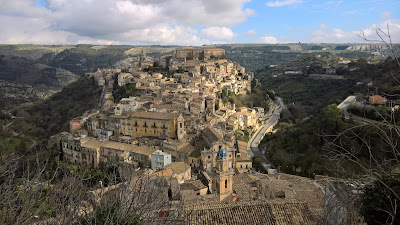

Left: View of Ragusa Superiore from Ragusa Ibla. Center: View of Ragusa Ibla from Ragusa Superiore. Right: The cupola of Duomo San Giorgio Ragusa Ibla at night.
Overview
To clarify, here we describe six winter days (February) in Ragusa. We did not make it to the coast at all, instead, we chose to focus on exploring cities and archaeological sites.We flew into Catania, rented a car, and drove to Ragusa. We chose to base ourselves in Ragusa and its province because it was a part of Sicily we wanted to learn more about. To this end, we dedicated 6 days (7 nights). In this post, we talk about some things you might consider if you are interested in visiting this area of Sicily.
We came to Sicily from Malta where we also spent six days. It was interesting to note the similarities and differences between the two islands. The first people to inhabit Malta are believed to have arrived from Sicily around 5200 BC. For the next few thousand years, those first Maltese people build megalithic stone structures that you don’t see at all in Sicily. The two islands were intimately connected during WWII, although on opposite sides: Italy and Germany used Sicily as starting point of bombers that pounded Malta for several years. And, of course, the two islands share similar Mediterranean weather and flora.
What was most strikingly different between the two islands was the immediate sense of space we got when we stepped foot in Sicily, which felt huge and spacious after coming from Malta. The density in Malta is 1,318 people/km2 compared to 198 people/km2 for the Province of Ragusa. (The world average density is 55 people/km2.) Another thing that hit us was the beauty and variation in Sicily’s landscape with its coasts, mountains, plateaus, large farm tracts, and wild areas.
The earthquake of 1693 (estimated at 7.4 MMS) was a devastating event for the Val di Noto. Val di Noto is the south-eastern part of Sicily which includes Ragusa and the Hyblean Plateau. It is estimated that up to 60,000 died, 5,000 alone in Ragusa, which was over half its population at the time. Out of the devastation came a period of building in a style referred to as Sicilian Baroque. Today, towns in the Val di Noto including Ragusa, are recognized for this rich architectural and artistic style. In recognition of this unique style, eight towns in the Val di Noto were inscribed into the UNESCO World Heritage List in 1992: Late Baroque Towns of the Val di Noto (South-Eastern Sicily).
Rebuilding after the 1692 earthquake in Ragusa resulted in a new urban center (Ragusa Superiore) created next to the old center one (Ragusa Ibla). Ibla is like a spur surrounded by gorges. Superiore is further west and a few hundred feet higher on average. Many of the iconic views looking down on Ibla are taken from Superiore.
The two parts of Ragusa are draped on the hills above the surrounding gorges, with beautiful views to the adjacent plateaus. Finding your way around will take a good part of a day. But rest assured that the most interesting walking routes between Superiore and Ibla will mean lots of stairs.
We stayed in Ragusa Ibla and were glad for our choice. While Ragusa Superiore is certainly characteristic in its own way, Ibla is more enchanting and there are plenty of restaurant choices and things to see. Specifically, we stayed at the Hotel Sabbinirica and we would highly recommend this hotel. From Sabbinirica it was easy to explore Ibla, yet also get to Superiore. A free parking lot is only a few minutes from the hotel by foot.




Examples of architecture in and round Ragusa. Left: Ragusa Cattedrale S. Giovanni Battista. Center left: Modica Chiesa del Carmine. Center right: Rosolini Chiesa Madre. Right: Ragusa Palazzo della Cancelliera.
What to expect
Driving. The geography around Ragusa and in general southeastern Sicily is such that straight shots in a car are rarely possible. Therefore, it takes time to drive between places. Our farthest outing from Ragusa was a 1.5 – 2.0 hour drive (each way) to the Necropolis of Pantalica, and that was pushing it in terms of time we like to be in a car. Be conservative in your driving estimates and factor in time for road deviations and blockages. On our way to Pantalica, for example, we hit a road deviation (we think due to a washed-out road) that had us back-tracking for some miles to take another route. On another day, on our way to visit a farm south of Scicli, all the train crossing gates were unexpectedly down and we needed to get to the other side of the tracks. We keep trying each crossing point further and further down the road with no luck. Finally, we barely squeezed through a tiny underpass used by farmers.Weather. We experienced some warm sunny days, one or two rain days, and some fabulous skies. At night, it was a little chilly but not below zero. We actually like walking and exploring in cooler weather, so all this was fine by us. The average weather patterns for the area are just that, average; be prepared for extremes and the unexpected.
One weather event that impacted us happened before we arrived: unusually heavy rain and storms in January 2017. We saw a lot evidence of storm and high water damage in the green spaces (gorges) around Ragusa, on roads in the mountains we took to Pantalica, and at Cava d’Ispica.
Trash. Sicily is a wonderful place, but you need to be prepared for stumbling on trash heaps on the side of the road. We still scratch our head as to why this is. It’s like this: you are driving along a country road and suddenly in a pull-out area there a junk heap, anything from bags of trash to discarded furniture. Around Ragusa, we went for a walk in the “Vallata San Leonardo Green Walk” and came across rubbish heaps, which was a bit disappointing.
Is it open? The upside of off-season travel is not too many tourists and feeling like you have the place to yourself. There were a number of restaurants where we were the only clients. (Good thing we made a reservation!?) The downside is that some places aren’t open as expected or they are on holiday themselves, which includes restaurants, museums, or other points of interest. As well, winter is the time to do routine maintenance for places like Ragusa where summer time is the high season.
Food. We found the food in the Ragusa area to be delicious, easy on the wallet, and very connected to the local traditions. During our stay, we were able to spend time talking with restaurant owners (one of those low season perks) and from them we got a sense of how proud they are of their local traditions. Yet, there was a willingness to be inventive and add new twists as well. Some of the food and dishes that were memorable for us on this trip include:
- Carob – A ubiquitous and beautiful tree in this part of Sicily whose dried pods are ground and used in pastas, cookies, etc. Carob is not just a chocolate substitute. We had several pasta dishes made with carob.
- Capuliata – An unctuous sun-dried tomato condiment. Good anytime of the day, sort of a Nutella of the south?
- Ricotta – Added to all dishes, from appetizers to desserts, the ricotta we ate during our stay was always smooth and delicious. It was predominantly ricotta from cow’s milk.
- Macco – A bean soup that appears on many menus.
- Biancomangiare – A milk pudding that is especially common in this area of Italy. Eating it for breakfast is especially a delight.
- Chocolate of Modica – Famous the world over, this is a cold-processed chocolate.
- Cassatelle ragusane- Little ricotta pastries with cinnamon, typical of Easter.
- Cavolo vecchio di Rosolini – A member of the cabbage family Brassicaceae (probably a form of Brassica oleracea), this plant has a long history in the Rosolini area where it was grown alongside the manure pile. It is called “vecchio” or old because the plant can live for 5-7 years. We ate it in a pasta dish at Antica Osteria U Suliccenti (in Rosolini).




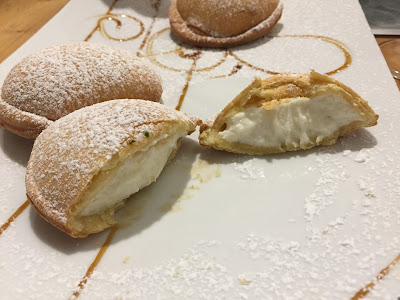
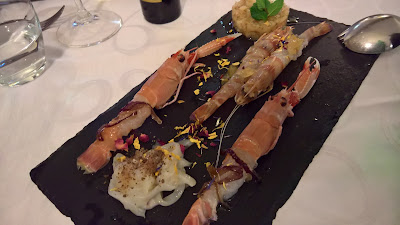

Examples of food during our 6 days. Upper left: Fish sample appetizer at Al Galu' Scicli. Upper center: Pasta made of carob at Antica Osteria U Suliccenti in Rosolini. Upper Right: Appetizer at Osteria U Suliccenti. Lower left: Breakfast items at Hotel Sabbinirica including cassatine ragusane. Lower left: Fried ricotta dessert at LoSteri Ragusa. Lower right: Fish at Ornato in Modica. Lower right: Spring onions wrapped in pancetta at Quattro Gatti in Ragusa.
Restaurants that we tried and would recommend include in Ragusa: LoSteri, Quattro Gatti, La Taverna del Lupo, and Taberna Dei Cinque Sensi; in Scicli: Ristorante La Galu; in Modica: Ornato Ristorante; in Rosolini: Antica Osteria U Suliccenti. We ate twice at both LoSteri and Quattro Gatti because they were that good. It didn’t hurt that they had ricotta-based desserts that weren’t easily forgotten: a fried ricotta-filled ravoli at LoSteri and a decomposed cannolo at Quattro Gatti.
Food growing. If you look at satellite photos of southeast of Sicily, you can’t help but notice what appears to be a lot of white structures. For example, see the satellite image included in this post, which is of the area around Vittoria, Sicily. The white structures are actually “greenhouses”, for growing vegetables under controlled conditions. The complexity of the structure and the materials used depend on what is grown inside. In Italy, cultivation in this manner is referred to as serricoltura and the structures are serricolo/serricoli. Here is an overview of serricoltura written Italian, however the pictures are enough to give you the idea. Much of the area around Vittoria (nearby Ragusa), in particular, is given over to growing vegetables in this manner, most of which is dedicated to tomatoes (I know: technically it’s a fruit).
Why do they do this in what seems to be a place with good weather? Well, good weather on average doesn’t mean there won’t be damaging winds or plunging temperatures or strong storms. And, despite good weather in a general sense, it’s not year-round, nor can it satisfy the year-round demand for vegetables. Hence, the protected growing conditions provide more or less controlled conditions throughout the year. There is a long history of protecting sensitive crops in this area. Before plastic, there were numerous other ingenious ways of protecting profitable crops like tomatoes.
We had the opportunity to visit one operation south of Scicli, Az. Agr. Giovanni Parisi. They grow tomatoes, carob, and a special type of bean called “il cosaruciaru di Scicli”, which means sweet thing “cosa dolce” in dialect. The day we visited, we spent time talking about tomatoes, and in particular, the variety datterino. Giovanni explained how the yearly cycle of tomato plants works, plucking a few ready datterini off the vine for us to taste. You can also buy a few of his products to take home. Who wouldn’t want a small jar of sun-dried tomatoes as a souvenir of your visit?

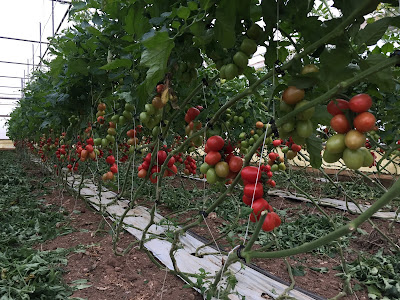
Left: Satellite map of the area Vittoria Sicily showing greenhouse structures. Right: In the greenhouse of Giovanni Parisi with datterini (tomatoes).
Things to tweak
No trip is ever prefect, and sometimes we Monday morning quarterback a little too much in the quest for perfection. Here it goes:Another base of operations? We spend 7 nights in Ragusa (about 6 full days). In retrospect, we might have shaved off a night or two off of our stay in Ragusa and spent them in a town in another part of Ragusa province or maybe even Noto. It would have been nicer to have stayed closer to Pantalica, like in Palazzolo Acreide. See driving tips above for more information.
Too much of a Baroque thing? While we visited the cities of Ragusa, and Scicli, Modica (three of the eight cities on the UNESCO list), we didn’t feel like we really got to know them, especially Scicli and Modica. Part of that was being a bit worn out on Baroque style at the same time really not understanding what to look for. We considered hiring a guide but didn’t and maybe that was a mistake.
I was also surprised at how many of the buildings (churches, palazzi, etc.) we closed or not accessible. Although a lot of the Baroque beauty is on the outside, it’s still nice to go inside and take a look around. In Ragusa, we found QR codes you could use to view the inside of a building. However nice that technological solution is, it made me less invested in what I was looking at since I couldn’t walk in and experience it in person. Here are the links associated with three QR codes we saw: Palazzo Cosentini Chiesa Santa Maria Itria (with the beautiful blue domed campanile), and Palazzo Arezzo Donnafugata.
Got a phone? Here are a few do-it-yourself tours of Ragusa that might be useful before heading to Ragusa: Baroque tour, Green tour, UNESCO tour, and the Montalbano tour.



View of Ragusa. Left: View from Ragusa Superiore. Center: View from Hotel Sabbinirica. Right: View from Via Solarino with view of cupola of Duomo San Giorgio.
Which necropolis? Our day at Cava D’Ispica was a bit of a miss. Our day at Pantalica was better. For more information, see the post A Walk Around the Necropolis of Pantalica. Advice: pick your tombs, rupestrian churches, and necropolis carefully, read up before you go, and/or get some professional guidance. There are tombs and archaeological features to see everywhere you look. If you are going to do one tomb/necropolis visit and have the means to do so, go to Pantalica. If you are going to Cava D’Ispica, do the northern part first and call ahead of time to make sure it's open.
Other case of the hit/miss nature of tomb hunting was late one afternoon when we went looking for sites near Ragusa. We found the interesting and easy to get to (with no open/close times) site Grotta delle Trabacche. But when we went looking for the the nearby Catacomba di Cisternazzi, we struck out. We just couldn’t find it. At this point, we hung up our Indiana Jones hats (actually just Tilleys) for the rest of the trip.
A day of Cava D’Ispica misadventures. We should have gone to northern part of the site first as suggested in the book “Walking in Sicily” [Cicerone], Walk 17: Cave d’Ispica. We instead went to the southern part first and when we got the northern part it was closed in the afternoon.
In the southern part, what could be a really cool attraction, Parco della Forza, was a dud. Parts were roped off, and while €2 isn’t a lot to pay to get in, there wasn’t much there to see. The most interesting feature called “Centoscale” an underground staircase was closed and totally out of the question. We asked. After leaving the Parco della Forza, we tried walking up the gorge, but due to recent rains and a majorly washed out trail, it was almost impossible. Today wasn’t our day.
We tried climbing up to some tombs above the gorge and suddenly out of nowhere a custodian (at least we think he worked at the park) summoned us down. He said his name was “papa” (Francesco?). He was playing with us, but he did show us around a bit: Santa Maria della Cava and the “Jewish” quarters where they worked animal hides. Then again, he could have made it all up. Talking with him – as difficult as it was through his dialect and our bad Italian – redeemed the visit. We threw the towel in around lunch and headed to Rosolini to eat at Antica Osteria U Suliccenti, redeeming the day even more.
During lunch, we kept staring at pictures of of Cava Lazzaro and Tomba del Principe that were hanging on the wall of the restaurant. After lunch, we decided to try and find them, which turned into a wild goose chase. This time there was no “papa” to save us. As the light faded, we ended up at the parking lot for Grotta dei santi, Tomba a finti pilastri, Grotta della Signora, and Grotta di S. Nicola. We did a quick tour of those and really threw the towel in for the day.



A day at Cava D'Ispica south. Left: Trying to make our way up the washed out ravine. Center: Floor detail of Chiesetta Rupestre di Santa Maria della Cava. Right: Talking to the custodian inside Chiesetta Rupestre di Santa Maria della Cava.
Winery tour? We spent one day north of Ragusa in the Chiaramonte Gulfi area. We spent about an hour and a half walking around the town, followed by a quick tour and lunch at the Locanda Gulfi winery. The winery tour was okay and the meal a bit expensive. We could have skipped both. On the other hand, the town of Chiaramonte Gulfi was unexpectedly charming, especially the Giardino Pubblico Comune and adjacent Balcone di Scilia and its panoramic views. The plants in the park were well-maintained with a number of them associated labels with the scientific and common plant names. That’s my kind of park.
On our way back to Ragusa, just above Chiaramonte, we parked the car (at an abandoned hotel) and took a short walk to Mount Arcibessi. That afforded views north, inland and south toward the coast.
Do a Montalbano themed-tour? A lot of Italians ask us if we did the “Montalbano tour”, that is, visiting the popular spots featured in the Montalbano TV series, which is based on the books by Andrea Camilleri. The majority of the places used in the series are actual places in Ragusa province: along the coast, some in Modica, and some in Ragusa Ibla, for example. If you are a fan or just passively interested, you could organize your time around Ragusa based on the places used in the series as described in i luoghi di Montalbano for the province, or in the Montalbano tour for just the city of Ragusa.



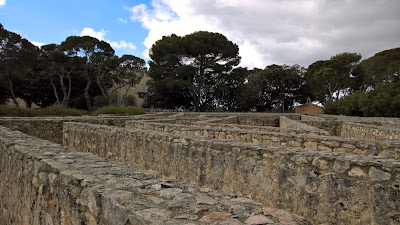
Views of Castello di Donnafuggata including sphinx, large banyan tree, garden, and stone labyrinth.
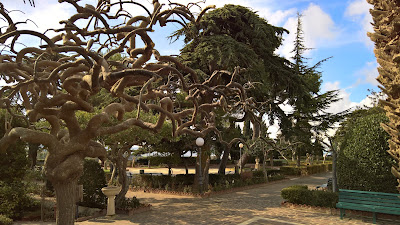

Left: Chiaramonte Gulfi public garden. Right: View from Locanda Gulfi winery.

Grotta delle Trabacche.


Left: Grotta delle Trabacche. Right: Above Grotta delle Trabacche, cows graze on the Ragusan plain.

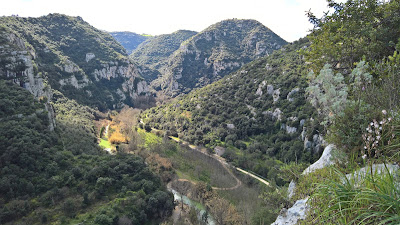
Views of Necropolis of Pantalica. For more information see the post A Walk Around the Necropolis of Pantalica.



Left: Ragusa Ibla, Piazza Duomo. Center: Giardino Ibleo, Ragusa Ibla. Right: Palazzo Cosentini, Ragusa Ibla.


Left: Underneath Ragusa Superiore. A large cavern that was once a quarry. Right: View of Hyblean landscape near Monte Ibleo.
No comments:
Post a Comment
All comments are moderated. If your comment doesn't appear right away, it was likely accepted. Check back in a day if you asked a question.